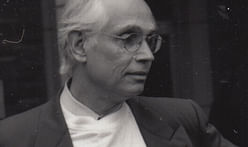anchor
Günther Domenig (1934-2012)
“He was an extremely talented architect who deserved to be better known but he wasn’t on the circuit and only spoke German,” said former chair of architecture at the Bartlett, Peter Cook. “In a way he was the architectural equivalent of Walter Pichler - he was an exponent of that kind of Austrian art. His bank was an extraordinary piece both formalistically and surface-wise.”
— bdonline.co.uk
Similar articles on Archinect that may interest you...
-

Michael Sorkin, visionary and incisive architect, educator, critic, has passed away from COVID-19
-

Vito Acconci, pioneering artist and architect, is dead at 77
-

Ray Kappe, founding director of SCI-Arc, and master of Southern California modernism, has died
-

Richard Weinstein, former UCLA architecture dean, dies at 85
-

Charles Correa, legendary Indian architect, dies at 84
-

Michael McKinnell, co-designer of Boston's Brutalist City Hall, dies from COVID-19

8 Comments
his steinhous is an beautiful and seminal poem of architecture. i don't know what is meant by being "better known" in this case but his work captured my imagination in a way that many other famous architects' didn't.
He was or he was not included in Austrian representation in 2010 Venice Architecture Biennale curated by Eric Owen Moss? (No he wasn't)
Did he reject the offer? I would be interested to know.
Why the alligator tears now about being known, recognition, importance etc..? (read Wolf D Prix, P Cook and possibly other friendly types who will emerge for klout.)
Finally, an english speaking journal covered the late great Gunther's death. He's work was radical beyond he's time, beyond he's predecessors (Coop Himmelblau, Zaha hadid, EOM, and etc), and clearly beyond mainstream fabric of contemporary architecture.
It doesn't appear enough people are paying attribute to he's unforgettable place in the annals of architectural history.
Will more people, please stand for Gunther?
Auf Wiedersehn, G.D
http://www.zugmann.com/online_exhibitions_domenig.php
Seeing one of Domenig's books as a first year student really blew me away.
Is he at the AA in that picture?
I always wondered why he wasn't in the decon exhibition, it seemed like Gehry copied this silhouette for Bilbao.
perhaps he did not carve out a paradigmatic media space for himself because his work was not as categorically specific or generically singular/distinctive as that of the era's "better known" architects. this also brings to my mind enric miralles, albeit with a different sensibility. theirs' were not so much specific approaches as they were ingenious amalgams of approaches.
But you are wrong there tammuz, he came before those better known architects.
Correction. I meat to say he's work was "beyond he's progenies", not predecessors.
what do you exactly mean, dimitri?
firstly, i think one should be careful here to admit when it is a matter of one's own opinion or when to be more specific in evaluating what his work was better at. i cannot think of pitting his work generally against zaha's for instance.
secondly, in no way did i situate his work below that of zaha hadid's, gehry's ..etc by pointing out something that they succeeded in presenting and representing (therefore as media figures as well as architects). to recast my previous post, he did not seem to possess an "ideological" aesthetic (if that makes sense) that translated into a trademark. zaha's iconic work and gehry's were recognizable to the point were they became genres being adopted by students around the world at one point. and i think, at that point, genres were very significant, perhaps existentially. you had siza, tadao ando, zaha, gehry, libeskind...auteurs... i don't think there is as much a need for genres now as there was then, the iconic architecture of this period is gravitating towards anonymity..whether under the tutelage of the parametricists or by way of hyper urban-onymous (i dont know if i just made up that neologism) architects the likes of OMA and MVRDV. of course, neither am i saying that gunther domenig fetishized anynomity per those mentioned. interestingly, gehry seemed to be working out his designs paradigmatically at some points (the fish, his house,the schnabel house) but did manage to reach the zenith of a syntagm with works such as the guggenheim....can one say that there is a natural inherent progression? sporadic thoughts.
aside...i think, to some extent, peter cook is correct in pointing out one disadvantage of not belonging - or having the facility of translating into- an anglo-centric world. think of behnisch - how many people know of his office's work compared to that of foster's - given that his work (behnisch) tends to be more evocative amongst the so-called "hi-tech" architects.
Block this user
Are you sure you want to block this user and hide all related comments throughout the site?
Archinect
This is your first comment on Archinect. Your comment will be visible once approved.